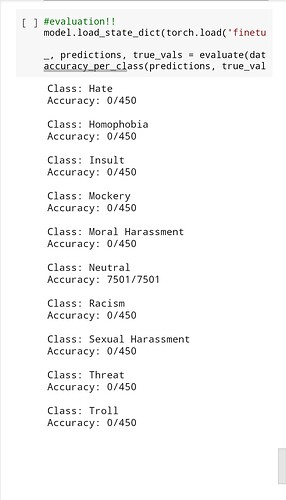Hello everyone,
For the last couple of days, I have been struggling with some code on how to train the french version of Bert (CamemBert) to classify some tweets (over 60.000) into 10 different classes. My biggest problem is that I don’t get any errors with the code below. It works fine and very well with other databases. With only 5 epochs, it gives higher results but with my database, it structures with a 0.5 F1 Score with even 10 epochs knowing that the 2 databases have the same structure which is even bizarre!
After mounting my drive and install all the needed packages, here is my code :
df = pd.read_csv('ALL.csv')
| commentaire | classement | |
|---|---|---|
| 0 | Nul à chier | Hate |
| 1 | VIDEO DE MERDE KFC EST TRES BIEN ET LE PDG VS … | Hate |
| 2 | il faut arreter de faire des videos clash roya… | Hate |
| 3 | 9 ans ou pas le branleur je me fous en slip ,j… | Hate |
| 4 | Nul | Hate |
#change all the label to int
possible_labels = df.classement.unique()
label_dict = {}
for index, possible_label in enumerate(possible_labels):
label_dict[possible_label] = index
label_dict
Neutral 50000
Hate 3000
Homophobia 3000
Mockery 3000
Racism 3000
Troll 3000
Moral Harassment 3000
Sexual Harassment 3000
Threat 3000
Insult 3000
Name: classement, dtype: int64
#split data : training \ test
from sklearn.model_selection import train_test_split
X_train, X_val, y_train, y_val = train_test_split(df.index.values,
df.label.values,
test_size=0.15,
stratify=df.label.values)
df['data_type'] = ['not_set']*df.shape[0]
df.loc[X_train, 'data_type'] = 'train'
df.loc[X_val, 'data_type'] = 'val'
df.groupby(['classement', 'label', 'data_type']).count()
{‘Hate’: 0,
‘Homophobia’: 1,
‘Insult’: 2,
‘Mockery’: 3,
‘Moral Harassment’: 5,
‘Neutral’: 6,
‘Racism’: 7,
‘Sexual Harassment’: 8,
‘Threat’: 9,
‘Troll’: 10,
nan: 4}
#I think the problem cames from here
#I tied to convert the data into lists
msgTrain = df[df.data_type=='train'].commentaire.astype(str).values.tolist()
msgVal = df[df.data_type=='val'].commentaire.astype(str).values.tolist()
tokenizer = CamembertTokenizer.from_pretrained('camembert-base', do_lower_case=True)
encoded_data_train = tokenizer.batch_encode_plus(msgTrain,
add_special_tokens=True,
return_attention_mask = True,
max_length=50,
padding=True,
truncation=True,
return_tensors = 'pt'
)
encoded_data_val = tokenizer.batch_encode_plus(msgVal,
add_special_tokens=True,
return_attention_mask = True,
max_length=50,
padding=True,
truncation=True,
return_tensors = 'pt'
)
input_ids_train = encoded_data_train['input_ids']
attention_masks_train = encoded_data_train['attention_mask']
labels_train = torch.tensor(df[df.data_type=='train'].label.values)
input_ids_val = encoded_data_val['input_ids']
attention_masks_val = encoded_data_val['attention_mask']
labels_val = torch.tensor(df[df.data_type=='val'].label.values)
dataset_train = TensorDataset(input_ids_train, attention_masks_train, labels_train)
dataset_val = TensorDataset(input_ids_val, attention_masks_val, labels_val)
model = CamembertForSequenceClassification.from_pretrained("camembert-base",
num_labels=len(label_dict),
#output_attentions=False,
#output_hidden_states=False
)
from torch.utils.data import DataLoader, RandomSampler, SequentialSampler
batch_size = 32
dataloader_train = DataLoader(dataset_train,
sampler=RandomSampler(dataset_train),
batch_size=batch_size)
dataloader_validation = DataLoader(dataset_val,
sampler=SequentialSampler(dataset_val),
batch_size=batch_size)
from transformers import AdamW, get_linear_schedule_with_warmup
#optimizer
optimizer = AdamW(model.parameters(),
lr=1e-3,
eps=1e-6)
epochs = 10
scheduler = get_linear_schedule_with_warmup(optimizer,
num_warmup_steps=0,
num_training_steps=len(dataloader_train)*epochs)
from sklearn.metrics import f1_score
def f1_score_func(preds, labels):#F1
preds_flat = np.argmax(preds, axis=1).flatten()
labels_flat = labels.flatten()
return f1_score(labels_flat, preds_flat, average='weighted')
def accuracy_per_class(preds, labels):#accurancy
label_dict_inverse = {v: k for k, v in label_dict.items()}
preds_flat = np.argmax(preds, axis=1).flatten()
labels_flat = labels.flatten()#all class in one vec
for label in np.unique(labels_flat):
y_preds = preds_flat[labels_flat==label]
y_true = labels_flat[labels_flat==label]
print(f'Class: {label_dict_inverse[label]}')
print(f'Accuracy: {len(y_preds[y_preds==label])}/{len(y_true)}\n')
import random
device = torch.device("cuda:0" if torch.cuda.is_available() else "cpu")
model = model.to(device)
def evaluate(dataloader_val):
model.eval()
loss_val_total = 0
predictions, true_vals = [], []
for batch in dataloader_val:
batch = tuple(b.to(device) for b in batch)
inputs = {'input_ids': batch[0],
'attention_mask': batch[1],
'labels': batch[2],
}
with torch.no_grad():
outputs = model(**inputs)
loss = outputs[0]
logits = outputs[1]
loss_val_total += loss.item()
logits = logits.detach().cpu().numpy()
label_ids = inputs['labels'].cpu().numpy()
predictions.append(logits)#recupr
true_vals.append(label_ids)
loss_val_avg = loss_val_total/len(dataloader_val)
predictions = np.concatenate(predictions, axis=0)
true_vals = np.concatenate(true_vals, axis=0)
return loss_val_avg, predictions, true_vals
for epoch in tqdm(range(1, epochs+1)):
model.train()
loss_train_total = 0
progress_bar = tqdm(dataloader_train, desc='Epoch {:1d}'.format(epoch), leave=False, disable=False)
for batch in progress_bar:
model.zero_grad()
batch = tuple(b.to(device) for b in batch)
inputs = {'input_ids': batch[0],
'attention_mask': batch[1],
'labels': batch[2],
}
outputs = model(**inputs)
loss = outputs[0]
loss_train_total += loss.item()
loss.backward()
torch.nn.utils.clip_grad_norm_(model.parameters(), 1.0)
optimizer.step()
scheduler.step()
progress_bar.set_postfix({'training_loss': '{:.3f}'.format(loss.item()/len(batch))})
torch.save(model.state_dict(), f'finetuned_BERT_epoch_{epoch}.model') #save epoch stat
tqdm.write(f'\nEpoch {epoch}')#num epoch
loss_train_avg = loss_train_total/len(dataloader_train)
tqdm.write(f'Training loss: {loss_train_avg}')
val_loss, predictions, true_vals = evaluate(dataloader_validation)
val_f1 = f1_score_func(predictions, true_vals)
tqdm.write(f'Validation loss: {val_loss}')
tqdm.write(f'F1 Score (Weighted): {val_f1}')
Results are all the same in every epoch like this :
That is all. Can anyone help me please ? maybe I did miss something important!

